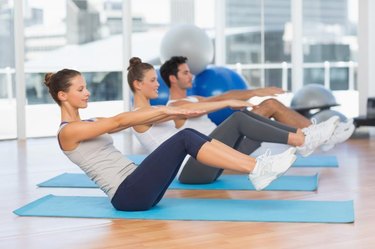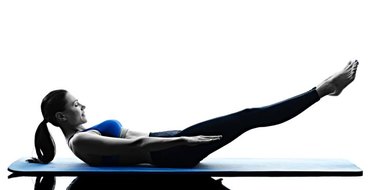
Dancers do it. So do swimmers and other professional athletes. Maybe you should too — but what exactly is mat Pilates?
Mat Pilates is a way to stretch and strengthen your body, primarily the muscles of the core, which span from your hips to your shoulders. Joseph Pilates developed this exercise methodology in the early 1900s, and it borrows from disciplines such as dance, yoga and classic calisthenics.
Video of the Day
Video of the Day
The standard Pilates system uses many different pieces of equipment, such as the reformer. But the mat Pilates series of exercises is performed equipment-free, with the moves adapted to work with just your body and a floor mat for cushioning and support.
You can practice in a Pilates studio or in many fitness centers that offer classes as part of your membership. Videos and online classes allow you to practice in the comfort of your own home, especially if you don't have easy access to a studio.
Read more: How to Get Started With Pilates for Beginners
Benefits of Mat Pilates
Mat Pilates focuses on the core, or the "powerhouse," as Joseph Pilates called it. You've probably heard how essential the core is in maintaining your health and preventing injury.
For example, a strong core helps ward off back pain and makes daily chores more doable. A strong core is a must for athletes, from runners to football players, as it increases stamina and power. Having a solid middle also supports you throughout pregnancy. When your core is strong, it serves as the center of power so your limbs don't have to bear as much of the brunt of movement.
Mat pilates may also help people who already have an aching back. Pilates was as effective, if not more so, in reducing pain and improving function in people with back pain, according to a July 2014 study published in PLOS One.
Common Mat Pilates Movements
The exercises included in a mat Pilates class vary from instructor to instructor. They also become progressively more difficult and complex as you practice over time. However, most classes based on the original teachings of Joseph Pilates begin with a warmup known as the hundred and move on to leg circles and roll-ups.
Hundred

- Lie on your back on a mat and draw your navel in to press your spine toward the floor.
- Extend your arms alongside your hips.
- Lift your legs up straight up the ceiling and then lower them to create about a 45-degree angle with the floor.
- Raise your head, neck and backs of the shoulders off the floor and elevate your arms several inches.
- Inhale briskly through your nose and exhale through your mouth as you pump your arms in conjunction with the breath. For example, do 5 pumps breathing in and 5 pumps breathing out.
- Work your way up to 100 repetitions.
Tip
If you're new to this movement, you can bend your knees to 90 degrees and keep your hips aligned with your knees throughout the exercise.
Roll-Up
- Lie on your back on your mat.
- Extend your legs out in front of you, keeping them in contact with the floor and squeezed together.
- Reach your arms next to your hips and slowly roll your head, neck and shoulders up off the floor, keeping your chin tucked toward your chest.
- Contract your abs as you continue to roll all the way up until you're draped over your thighs, your spine making the shape of a letter C.
- Use control to roll back down to complete one repetition.
Leg Circles
- Lie on your back with your arms planted on the floor alongside your hips.
- Reach your right leg up to the ceiling.
- Leave the left leg long on the mat, or bend your knee and plant your foot if your back arches when your leg is straight.
- Point your right toe and, pretending it's like the tip of a pencil, draw five to eight precise circles to the right. Make sure to keep your hips centered and steady.
- Switch directions and draw five to eight circles to the left.
- Repeat the circles on the left.
Read more: 10 Beginner Pilates Exercises You Can Do at Home
Was this article helpful?
150 Characters Max
0/150
Thank you for sharing!
Thank you for your feedback!